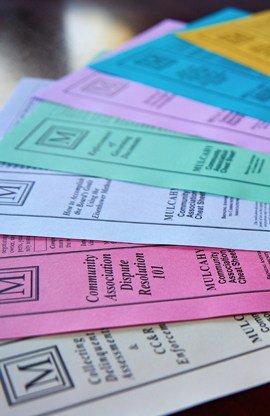Transition From Developer Control
The transition from developer control occurs when control of the association shifts from the developer to the owners. The transfer of control can occur in several ways. However, the most common method is a weighted voting approach whereby the membership voting ratio is arranged so that the developer will transfer control to the association after a specific percentage of the homes have been sold (typically 75%).
Ideally, the transfer of control from the developer to the owners should occur through an extended process of transition during which the owners gradually become involved in the association’s operations and decisions. Some associations create one or more homeowner committees (such as transition, maintenance, finance, management, or insurance) that investigate and identify problem areas between the association and the developer and bring them to the developer’s attention with recommendations. In addition, these committees provide excellent training opportunities for future board members regarding the issues that face an association.
Common Transition Issues
In some instances, there are outstanding issues between the developer and the owners at the time of transition. Set forth below are the most common transition issues:
1. Construction Defects: We suggest that associations in the transition process consult
with an engineer to create a punch list of defects, determine the nature and extent of the defects and consider the possible remedies. (Examples of construction defects may include: leaky roofs, windows, and balconies; stucco cracks; grading and drainage problems; settlement and cracking of foundations; and damaged sidewalks.)
2. Failure to Adequately Fund a Reserve Account: The association’s developer has a fiduciary duty to adequately fund the association’s reserve account. The association should consider obtaining a reserve study or advice from a qualified reserve analyst regarding how much money should be/have been in the reserve account and/or general checking account at the time of transition.
3. Failure to Deed Common Areas to the Association: This problem can be
corrected by the developer quit claim deeding the association’s common area to the association.
4. Misappropriation of Association Funds: The association should consider hiring an independent certified public accountant to conduct an audit of the association’s books and records to determine if the developer has paid “developer” expenses with association funds.
Obtain Advice
We strongly suggest that a transition committee or the board (post-transition) obtain advice from an independent legal counsel who represents community associations (i.e. not the developer’s attorney) regarding any unresolved transition issues before the transition or shortly after the transition. Several Arizona laws affect how long an association has to bring suit against a developer and there is a detailed process an association must follow under Arizona law to bring a legal claim against a developer.
Mulcahy Law Firm, P.C. provides a free consultation to the association’s transition committee or the board of directors (post-transition).
To-Do List
- Determine that common areas have been properly transferred to the association (if the association is a planned community). Change the address for the common area property taxes with the County Treasurer and Assessor (if the association owns common areas).Change the statutory agent/address of the corporation, if necessary, with the Arizona Corporation Commission.
Record a new Notice of Contact Information with the Maricopa County Recorder’s office.
Check existing contracts (landscaping, management, etc.) to determine liability for the association, terms, and cancellation policies.
Read and understand the governing documents.
Consult with a qualified community association attorney on matters dealing with transition.
A Checklist Of Documents For Transition
| Association Documents
__ CC&Rs and any amendments Association Meeting Documents __ Regular meeting minutes past and present Financial Documents __ Annual federal and state tax returns since the date of incorporation Policies __ Collections policy Enforcement Files __ Enforcement records __ Violation histories Miscellaneous __ Annual report filed with the Arizona Corporation Commission |
Architectural History
__ Architectural guidelines, standards, and files Maintenance __ Reserve study, with the date of completion PUBLIC REPORTS/OFFERINGS Disclosure Documents __ Statement that street, traffic, safety, and regulatory signs are installed in conformance with state or local ordinances and association documents
|
